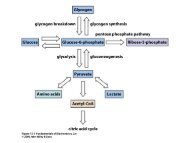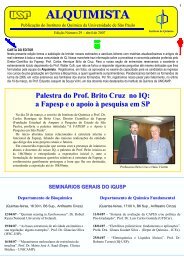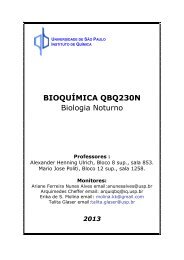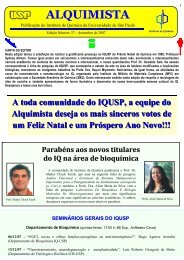Studies on PVP hydrogel-supported luminol ... - ResearchGate
Studies on PVP hydrogel-supported luminol ... - ResearchGate
Studies on PVP hydrogel-supported luminol ... - ResearchGate
You also want an ePaper? Increase the reach of your titles
YUMPU automatically turns print PDFs into web optimized ePapers that Google loves.
Calibrati<strong>on</strong> analytical applicati<strong>on</strong>s studies <strong>on</strong> <strong>PVP</strong> <strong>hydrogel</strong>-<strong>supported</strong> <strong>luminol</strong> CL ORIGINAL RESEARCH ORIGINAL RESEARCH7between the antiradical compound and <strong>luminol</strong> for theoxidizing species, e.g. Hem–Fe(IV) in the polymermatrix system (light intensity inhibiti<strong>on</strong> = 0.02 + 0.21[Trolox]; R = 0.9971, n = 5). This competiti<strong>on</strong> leads tolower emissi<strong>on</strong> intensities in steady-state c<strong>on</strong>diti<strong>on</strong>s inthe presence of the antiradical and also to lower totalemissi<strong>on</strong> areas. Depending <strong>on</strong> the specific applicati<strong>on</strong>,both parameters (suppressi<strong>on</strong> area and intensity inhibiti<strong>on</strong>)can be utilized to quantify antiradical capacity, asshown by the linear correlati<strong>on</strong> between the two parametersand the Trolox c<strong>on</strong>centrati<strong>on</strong> (Fig. 4B, C).The different behaviour of the <strong>PVP</strong>-<strong>supported</strong><strong>luminol</strong> CL system, as compared to analogous aqueousassays (20), is supposed to be related to diffusi<strong>on</strong> factorsin the polymer system. One possible explanati<strong>on</strong>could be that the reacti<strong>on</strong> rate might be determinedmuch more by the diffusi<strong>on</strong> of the species than by itsreactivity, thereby ‘masking’ the much higher reactivityof the antiradical Trolox towards the oxidizing speciesand allowing the competiti<strong>on</strong> by <strong>luminol</strong> ani<strong>on</strong>, even ifboth species are present in comparable c<strong>on</strong>centrati<strong>on</strong>s.In fact, in the system studied the <strong>luminol</strong> c<strong>on</strong>centrati<strong>on</strong>is three orders of magnitude higher than the Troloxc<strong>on</strong>centrati<strong>on</strong>; however, in the analogous aqueoussystem Trolox is sufficiently more reactive and ableto scavenge all the oxidizing species present until itseffective complete depleti<strong>on</strong> (20). Whatever may bethe exact reas<strong>on</strong> for the different behaviour of theaqueous and <strong>PVP</strong>-<strong>supported</strong> <strong>luminol</strong> CL system in thepresence of an antiradical compound, it is shown in thiswork that the polymer-<strong>supported</strong> system can beperfectly utilized for antiradical capacity determinati<strong>on</strong>and opens up the possibility of automati<strong>on</strong> usingmicroplate luminometers.CONCLUSIONSIn c<strong>on</strong>clusi<strong>on</strong>, we have shown that the <strong>PVP</strong> <strong>hydrogel</strong> CLsystem can be utilized up to 90 days after preparati<strong>on</strong> forthe determinati<strong>on</strong> of hydrogen peroxide c<strong>on</strong>centrati<strong>on</strong>and as an antiradical capacity assay, since optimizedc<strong>on</strong>diti<strong>on</strong>s are used to maximize its sensibility and reproducibility.Furthermore, it can be c<strong>on</strong>veniently utilizedfor the calibrati<strong>on</strong> of microplate luminometer PMTsand, c<strong>on</strong>sequently, the determinati<strong>on</strong> of CL quantumyields. This approach allows the direct comparis<strong>on</strong> of theexperimental results (emissi<strong>on</strong> intensities and total lightemissi<strong>on</strong>) obtained in different research laboratories.AcknowledgementsA d<strong>on</strong>ati<strong>on</strong> of 60% hydrogen peroxide by Solvay–Peróxidos do Brasil LTDA Co. is gratefully acknowledged.This work was <strong>supported</strong> by Fundação deAmparo à Pesquisa do Estado de São Paulo (FAPESP;Copyright © 2006 John Wiley & S<strong>on</strong>s, Ltd.98/05445-9, 00/06652-0, 01/07477-0), C<strong>on</strong>selho Naci<strong>on</strong>alde Desenvolvimento Científico e Tecnológico (CNPq),Coordenação de Aperfeiçoamento de Pessoal de NívelSuperior (CAPES) and Programa de Apoio ao DesenvolvimentoCientífico e Tecnológico (PADCT).REFERENCES1. Merényi G, Lind J, Eriksen TE. Luminol chemiluminescence—chemistry, excitati<strong>on</strong>, emitter. J Biolumin. Chemilumin. 1990; 5:53–56.2. Rao PS, Luber JM Jr, Mil<strong>on</strong>owicz J, Lalezari P, Mueller HS.Specificity of oxygen radical scavengers and assessment of thefree radical scavenger efficiency using <strong>luminol</strong> enhancedchemiluminescence. Biochem. Biophys. Res. Commun. 1988; 150:39–44.3. Yildiz G, Demiryürek AT, Sahin-Erdemli I, Kanzik I. Comparis<strong>on</strong>of antioxidant activities of aminoguanidine, methylguanidineand guanidine by <strong>luminol</strong>-enhanced chemiluminescence. J.Pharmacol. 1998; 124: 905–910.4. Yildiz G, Demiryürek AT. Ferrous ir<strong>on</strong>-induced <strong>luminol</strong>chemiluminescence: a method for hydroxyl radical study. J.Pharmacol. Toxicol. Methods 1998; 39: 179–184.5. Parejo L, Codina C, Petrakis C, Kefalas P. Evaluati<strong>on</strong> ofscavenging activity assessed by Co(II)/EDTA-induced <strong>luminol</strong>chemiluminescence and DPPH center dot (2,2-diphenyl-1-picrylhydrazyl) free radical assay. J. Pharmacol. Toxicol. Methods2000; 44: 507–512.6. Hool K, Nieman TA. Immobilized <strong>luminol</strong> chemiluminescencereagent system for hydrogen peroxide determinati<strong>on</strong>s in flowingstreams. Anal. Chem. 1988; 60: 834–837.7. Coulet PR, Blum LJ, Gautier SM. Luminescence-based fiberopticprobes. Sens. Actuators B 1993; 11: 57–61.8. Collins GE, Rose-Pehrss<strong>on</strong> SL. Chemiluminescent chemicalsensors for oxygen and nitrogen dioxide. Anal. Chem. 1995; 67:2224–2230.9. Janasek D, Spohn U. An enzyme-modified chemiluminescencedetector for hydrogen peroxide and oxidase substrates. SensActuators B 1997; 39: 291–294.10. Collins GE, Rose-Pehrss<strong>on</strong> SL. Chemiluminescent chemicalsensors for inorganic and organic vapors. Sens. Actuators B 1996;34: 317–322.11. Bastos EL, Ciscato LFML, Bartol<strong>on</strong>i FH, Catalani LH, BaaderWJ. <str<strong>on</strong>g>Studies</str<strong>on</strong>g> <strong>on</strong> <strong>PVP</strong> <strong>hydrogel</strong>-<strong>supported</strong> <strong>luminol</strong> chemiluminescence:1. Kinetic and mechanistic aspects using multivariatefactorial analysis. Luminescence 2006; 21 (in press).12. Cott<strong>on</strong> ML, Dunford HB. <str<strong>on</strong>g>Studies</str<strong>on</strong>g> <strong>on</strong> horseradish peroxidase.XI. On the nature of compounds I and II as determined from thekinetics of the oxidati<strong>on</strong> of ferrocyanide. Can. J. Chem. 1973; 51:582–587.13. Scolaro LM, Castriciano M, Romeo A, Patanè S, Cefali E,Allegrini M. Aggregati<strong>on</strong> behaviour of protoporphyrin XI inaqueous soluti<strong>on</strong>: clear evidence of vesicle formati<strong>on</strong>. J. Phys.Chem. B 2002; 106: 2453–2459.14. Rabek JF. Experimental Methods in Photochemistry andPhotophysics. Wiley: Bath, 1982.15. Lee J, Seliger HH. Spectral characteristics of excited states ofproduct of chemiluminescence of <strong>luminol</strong>. Photochem. Photobiol.1970; 11: 247–258.16. Lee J. Spectroscopic characterizati<strong>on</strong>s of <strong>luminol</strong> chemiluminescence.Appl. Spectrosc. 1971; 25: 142.17. Lee J, Seliger HH. Quantum yields of <strong>luminol</strong> chemiluminescencereacti<strong>on</strong> in aqueous and aprotic solvents. Photochem. Photobiol.1972; 15: 227–237.18. Baader WJ, Stevani CV, Bastos EL. Chemiluminescence oforganic peroxides. In The Chemistry of Peroxides, Rappoport Z(ed.). Wiley: Chichester, 2006; 1211–1278.19. O’Kane DJ, Lee J. Absolute calibrati<strong>on</strong> of luminometers with lowlevellight standards. Methods Enzymol. 2000; 305: 87–96.20. Bastos EL, Romoff P, Eckert CR, Baader WJ. Evaluati<strong>on</strong> ofLuminescence (In press)DOI: 10.1002/bio


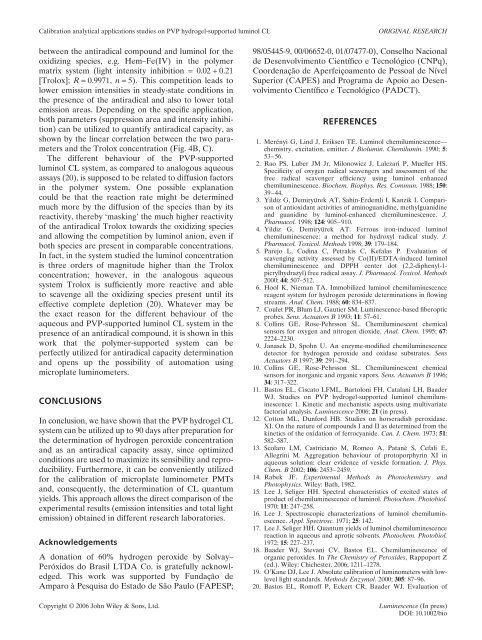
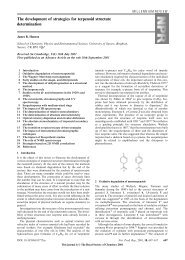
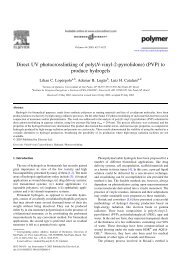
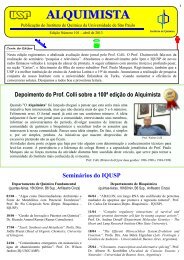
![PE]+ + N. Fragmentação por clivagem sigma](https://img.yumpu.com/50134385/1/180x260/pe-n-fragmentaaao-por-clivagem-sigma.jpg?quality=85)




